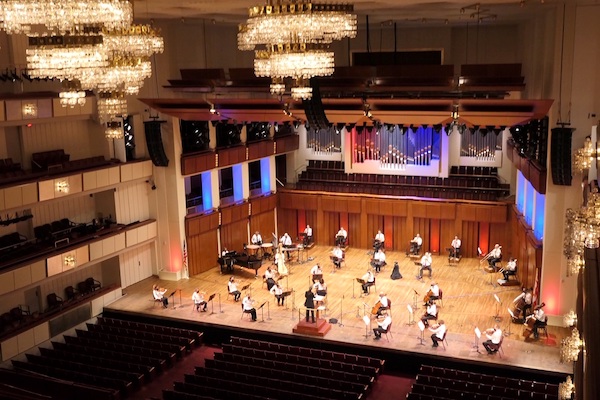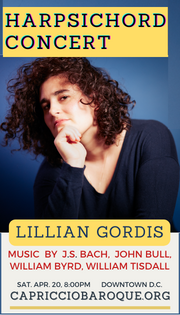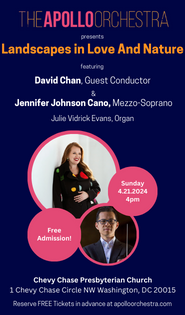Summer night at the drive-in with the National Symphony Orchestra

Classical music presenters continue to search for innovative ways to present live concerts during the pandemic.
After taking part in outdoor garden concerts, the National Symphony Orchestra tried a drive-in simulcast on Sunday evening. A slimmed-down assortment of musicians played the annual Labor Day concert in the Kennedy Center Concert Hall, led by guest conductor Michelle Merrill, former associate conductor of the Detroit Symphony Orchestra. Across town listeners watched on the big screen set up in the parking lot of RFK Stadium.
The experience was more comfortable than standing outdoors, protected from the heat and the mosquitoes inside one’s car. The sound, heard by tuning the car radio to a certain frequency, did not approach the thrill of the live experience, but seeing the familiar faces of the NSO musicians and actually watching them play on their accustomed stage brought comfort as well as pleasure. Real concerts will return one day, and until then events like this will have to do.
Following health department guidance, the musicians wore masks, except for the small number of brass and woodwind players, who appeared only toward the end of the program. In their summer attire of white tops and black slacks, the chamber orchestra sat spaced apart at safe distances. This arrangement limited the number of musicians who could perform.
In the Gianandrea Noseda era the NSO has already shown a preference for more serious fare on these holiday concerts. The Labor Day focus on contemporary American composers in recent years continued, now fitting in aptly with the Kennedy Center’s commitment to championing music by African American composers.
Music for strings filled the first half of this 75-minute concert, beginning with Strum, a vivacious work originally for string quartet by Jessie Montgomery, the composer-in-residence for the Sphinx Virtuosi. Rhythmically energized by plucking and strumming motifs, the piece is a series of folk-infused sections, often in shifting meters. This performance had verve and joy, if the precision of ensemble cohesion was lacking at times.
Washington, D.C. native George Walker’s lush Lyric for Strings offered a contrast. This youthful work launched a career that included being the first African American composer to win the Pulitzer Prize, some fifty years later. The NSO strings under conductor Merrill coaxed melting beauty from its slow, tender phrases.
A triptych of pieces by William Grant Still took the program back into dance territory, with two movements from Danzas de Panama, “Tamborito” and “Cumbia y Congo.” Based on Panamanian folk songs, the score calls for the string players to add a percussive beat by rapping on the underside of their instruments. The lullaby “Mother and Child,” arranged for string orchestra from the composer’s Violin Suite, made a calming middle movement, featuring a lyrical cadenza by first violinist Alexandra Osborne.
The program remained in Latin America with “Coqueteos” from Gabriela Lena Frank’s An Andean Walkabout. The flirtations of the title came across vividly in glissando and other string effects, offering another glimpse of the rich multicultural influences on American music.
Aaron Copland’s suite from Appalachian Spring, heard here in the original version for thirteen instruments, dates from the 1940s like the Walker and Still pieces. The music’s misty optimism, reflecting the American pioneer story of the Martha Graham ballet it accompanied, provoked a welcome shiver of nostalgia, not least due to the excellent playing of flutist Aaron Goldman, clarinetist Eugene Mondie, and bassoonist Sue Heineman.
Merrill’s hand seemed most sure in the Copland work, presiding over a performance that was expertly paced, skillfully coordinated, and replete with beauty. In particular, the Shaker tune “Simple Gifts” felt set at just the right tempo, spritely but not frenetic. The full swell of the conclusion, while lacking the heft of the later orchestral arrangement, made a fitting conclusion for this program, capped by Charles Kessler’s Hollywood-style arrangement of America the Beautiful.
How does one applaud the musicians at a drive-in theater, even though they cannot hear you? The assembled cars broke forth in a symphony of twilight honking, of course. Yes, that meant some beeping between movements, too, but no one was complaining: the music was back.
The Kennedy Center is streaming this concert at kennedy-center.org






